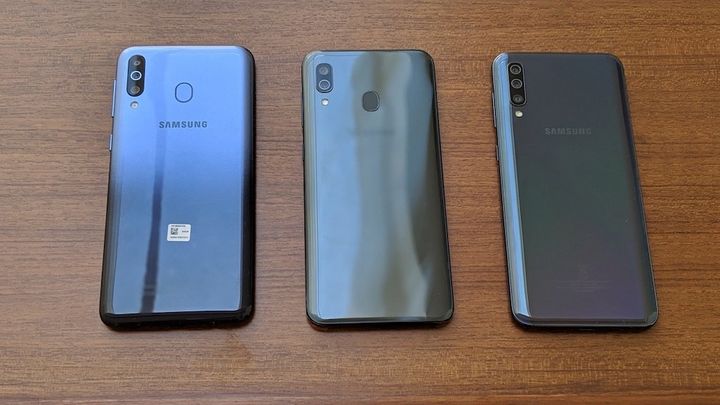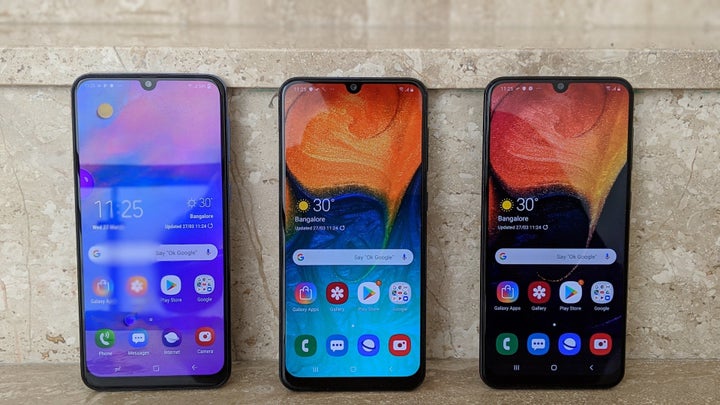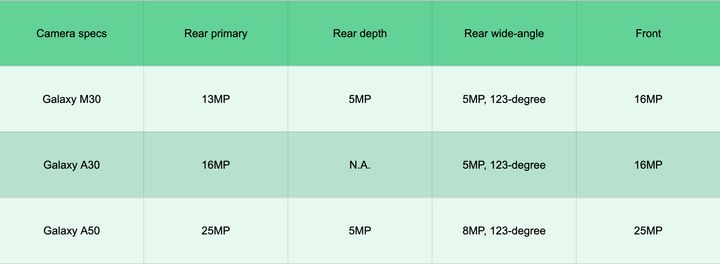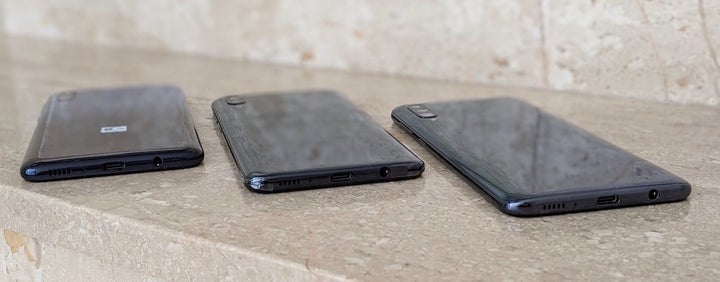Although Chinese companies like OnePlus and Xiaomi have been steadily taking over Samsung’s budget segment, the Korean giant is starting to fight back. Things changed with the M-series in 2019, and a reinvigorated Samsung is back to doing what it does best – peppering a segment with phones at practically every imaginable price point.
And so, where the Samsung Galaxy M10 and Galaxy M20 are filling in the entry level, with the recently launched Galaxy M30, Galaxy A30 and Galaxy A50 it steps up the budget a notch.
The three phones are in the Rs. 15,000 to Rs. 20,000 bracket, with the M30 starting at Rs. 14,990 joined by the A30 at Rs. 16,990 and the A50 at Rs. 19,990.
They look similar, carry somewhat similar specs and are only barely differentiated on pricing, so if you’re looking to tell them apart, here’s our quick primer on how to pick one of the three that suits you best.
Samsung Galaxy M30, A30, and A50 look and feel
It’s easy to mistake one for the other, since all three models sport a now-familiar Samsung look—blame the large, 6.4-inch Full HD+ Super AMOLED panel with the teardrop notch and that noticeable chin that all three share—but it’s really when you start using them that the not insignificant differences are evident.
The Samsung Galaxy M30 takes the M10 and M20 design a step forward with an understated gradient finish on the rear, while the Galaxy A30 and the A50 get a tapering ultra-glossy finish that looks like glass but really is highly reflective plastic, a finish that looks slick but is highly prone to smudges.

The Galaxy A50 unit we had was a black variant, but Samsung’s given it an iridescent rainbow-like effect which shows off different colors depending on the angle of light falling on it, very S10-inspired. The M30 and the A30 get a fingerprint scanner on the rear, albeit one that is placed a bit too high for our liking, while the A50 gets an in-display fingerprint scanner.
It’s not the ultrasonic variety that we’ve seen on the flagship S10-series, but a slower variant that takes a couple of seconds to unlock—face unlock is faster.
Samsung Galaxy M30, A30, and A50 performance
If performance is your primary consideration, the Galaxy A50 sets itself apart with its new octa-core Exynos 9610 chipset, which is a class above the Exynos 7904 that the other two use courtesy its four Cortex-A73 cores, four Cortex-A53 cores, and the higher performing Mali G72-3 GPU. That said, you should be happy with the performance of any of the three, as they perform capably on a day-to-day basis. The Galaxy A50 however allows you to run games like Asphalt and PUBG Mobile on their ‘High’ settings.

Both the Galaxy M30 and the Galaxy A50 get a 6GB memory variant, but only the higher specced M30 variant gets you 128GB of built-in storage. You’re still limited to 64GB storage on the 6GB RAM variant of the Galaxy A50. It’s worth noting that the A-series models differentiate themselves by including the latest One UI based on Android 9 Pie, while the Galaxy M30 gets older Samsung Experience 9.5 UI based on Android Oreo 8.1.
Samsung’s problem with spammy lock screen ads continues on all these devices, but the A-series models let you disable “lock screen stories” during the initial setup.
Samsung Galaxy M30, A30, and A50 battery life
Muddling the waters is the battery discussion, where the Galaxy M30 pulls ahead of it’s A-series cousins by packing in a 5000mAh battery (as compared to the 4000mAh unit on the Galaxy A30 and A50).
With our usage, which included watching stream videos, the usual everyday banter on Whatsapp groups and the occasional GPS navigation, the M30 gives you an additional half a day of use, typically 1.5-2 days to the A series’ full day of use.
Samsung Galaxy M30, A30, and A50 cameras
This is where things get interesting, so let’s take a look at how each unit is kitted out in the camera department. The Galaxy M30 has a 13MP f/1.9 primary with a 5MP f/2.2 depth sensor and a 5MP ultra-wide-angle 123-degree field of view camera, whereas the Galaxy A50 ups the ante by offering a 25MP f/1.7 primary with the same secondary 5MP depth sensor and an 8MP ultra-wide.
The Galaxy A30 makes do with only a 16MP f/1.7 primary and a secondary 5MP ultra-wide, and it shares the 16MP f/2.0 selfie camera with the M30 while the A50 gets a higher resolution 25MP f/2.0 selfie shooter.

Daytime shooting on all three were sharp and offered good details, and the wide-angle camera gives you a lot of flexibility while shooting landscapes and groups, if you’re willing to live with the reduced quality and barrel distortion that isn’t just limited to the far edges of the frame (ergo: use it sparingly).
Low-light performance on the Galaxy M30 and the Galaxy A30 was about average despite their wide apertures, and the A50 just about edged ahead of the other two with its slightly better low-light performance… even though objectively speaking, it’s nothing that would blow you away.
Samsung Galaxy M30, A30, and A50 verdict
With three phones with different strengths, it comes down to price points and what you want from your phone. The M30 is a big step up from the M10 and M20, and justifies the price bump on account of the better display and the capacious battery (no One UI though).
The Galaxy A30 on the other hand is stuck in the middle, with its better build quality not really justifying the marginal difference between itself and the higher specced Galaxy M30 (with more RAM, more storage and a bigger battery).

The Galaxy A50 does redeem itself with the better cameras and slicker design, but it starts venturing into the Poco F1 territory, where the Snapdragon 845 blows it out of the water on pure performance. As a result, it’s the Galaxy M30 that really comes out on top—it offers much of the same experience as the other two, and in some departments a wee bit more…for much, much less money.